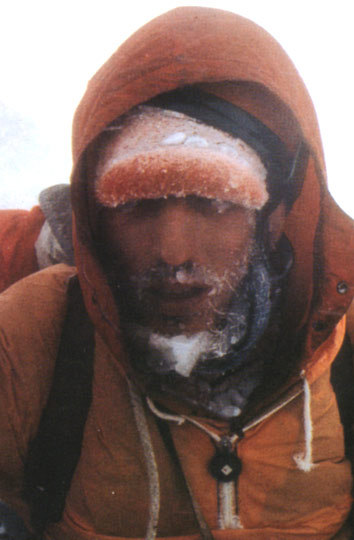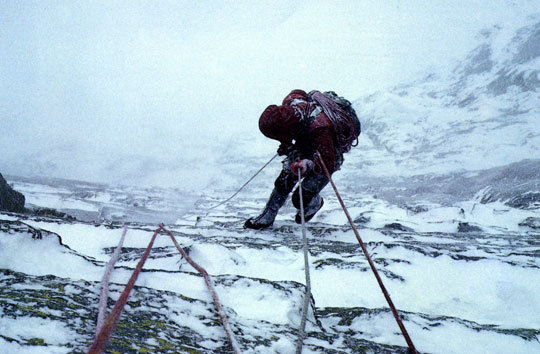
Antonio Rusconi, 1945-2008, on the summit of the Piz Badile, Bregaglia, Switzerland in March 1970 after the historic first ascent of the Brother’s Route on the east-northeast pillar. Rusconi died of a brain tumor on April 14, 2008. [Photo] Gianni Rusconi
The Italian alpinist Antonio Rusconi died of a brain tumor on April 14, 2008. In the ground-breaking years of winter climbing in the Alps, the Rusconi brothers, Antonio and Gianni, became something of a legend. They first became noticed in the world of alpinism in 1968 with their first winter but only second overall ascent of the southwest face Direttissima on Torre Trieste (2458m) in the Civetta Group of the Italian Dolomites. This impressive route up the 700m sheer face between the now-classic Carlesso-Sandri and Cassin-Ratti routes was put up in 1959 by Piussi and Redaelli at the old UIAA grade of VI/VI+ (probably around 5.8 at the time) and A4. The following year the Rusconis were joined by Chiappa and Lanfranchi for the coveted first winter ascent of the Guides Route on the Crozzon di Brenta (3135m), the 1935 classic on the 800m east-northeast face by Detassis and Giordani, which now goes at about 5.8. The four Italians made six bivouacs on the wall before reaching the summit.
In 1970 they completed perhaps their finest contribution with the first ascent of the Brother’s Route on the east-northeast pillar of the Piz Badile. The prominent crack line on the broad rounded pillar, left of the central depression on the famous northeast face, had been an object of attention since 1935. The brothers made almost weekly attempts during January and February 1970 but were unable to break through a band of overhangs a few hundred meters up the face. Finally, in a tour de force from March 14-19, during which they reportedly spent five nights bivouacked in miserable conditions on a small ledge below the overhangs, they completed the route and descended the far side of the mountain to the Gianetti Hut. This ca. 750m route would gain popularity when it was discovered that it was less demanding than most other routes later added to this wall. The route was named after their older brother, Carlo Rusconi, who was killed climbing in the Grigne in 1955 (at the time he fell to his death he was climbing with Claudio Corti of Eiger fame). The Brother’s Route can be climbed in around twenty short pitches, followed by another eight or ten of easier mixed ground to reach the summit. The Rusconi brothers used a lot of aid but the route would later be climbed in summer at around 5.8 and A2, eventually going free at TD+ 5.10d. In more recent years access difficulties, notably an almost insuperable rimaye at the base of the Cengalo Couloir, have led to ascents becoming increasingly rare. It did not have a second winter ascent until December 2006 when, in far more clement conditions than thirty-six years previous, it was soloed in six days by Fabio Valseschini as mentioned in the February 28, 2008 Newswire.
The following year the Rusconi brothers returned to the Bregaglia and from February 4-15 put up Attilio Piacco on the sombre north-northwest face of the Piz Badile’s taller neighbor, Pizzo Cengalo (3370m). The 1300m wall was climbed in ca. thirty-one pitches at around 5.8 and A3 (large bongs used) and was, at the time, the biggest and hardest route climbed so far in the Bregaglia. Accompanying them were other well-known activists of the day Heinz Steinkotter and Giorgio Tessari.
In the summer of that year, 1971, they tried their hand at the Greater Ranges, visiting the St. Elias Range to attempt the first ascent of the northeast spur. The team passed the main difficulties, and were only 600m of relatively easy ground from the top, when the weather deteriorated rapidly. They produced a 250m rope and made monster rappels to escape. However, during the expedition Antonio and two companions made an early repeat of the original Abruzzi Route.
In the winter of 1972 they returned to the Dolomites and the “Wall of Walls,” the north face of the Civetta. From March 16-22 they established the Via dei Cinque di Valmadrera with Crimella, Tessari and Villa, which climbs the almost-1200m-high wall to the right of the celebrated Philipp-Flamm Diedre at around 5.9 and A3. Again, the team made several attempts over the winter before winning through. In 1973 most of that team would return to make the much-prized first winter ascent of the Philipp-Flamm Diedre (5.10d, 1050m, Flamm-Philipp, 1957), but Antonio was not part of the group on this occasion. Over the next few winters the brothers would concentrate on the Mont Blanc Range, notably making the first winter ascent of the rarely climbed Bonatti-Zappelli on the east face of the Grand Pilier d’Angle.
The Rusconi brothers’ achievements were not without controversy. They often justified the use of fixed ropes and extensive aid due to the severity of the season, and there is no doubt that alpine winters in those times were considerably colder, more snowy and far harsher than is generally the case today. However, the bottom line was that even the most forceful critics came to admire their incredible resilience and huge tenacity that allowed them to battle for many consecutive days through appalling conditions to reach the summit.
According to Italian mountaineer Carlo Caccia, Antonio Rusconi was a real gentleman with uncommon patience. Although a man of few words, who shunned the limelight and was always modest of his achievements, he remained passionate about his climbing. His brother Gianni and Andrea Frigero have recently put together a film, Gli Anni dei Lunghi Inverni, about those distant winter days in the Alps.

Antonio Rusconi in action during the first ascent of the Brother’s Route (TD+: 5.8 A2, 5.10d all free, 750m, Rusconi-Rusconi, 1970) in typical winter conditions for that era on the northeast face of the Piz Badile. [Photo] Gianni Rusconi